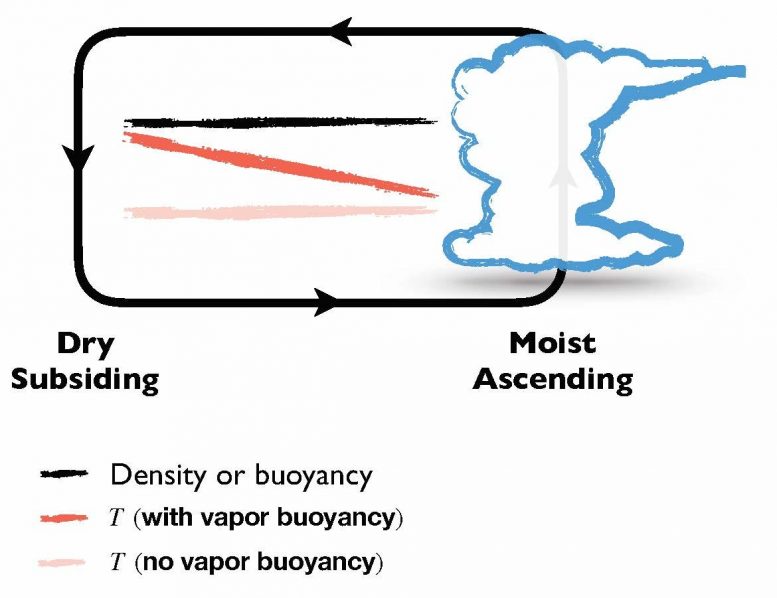
This graphic illustrates the vapor buoyancy effect, in which cold, humid air rises because it is lighter than dry air. Credit: Da Yang/UC Davis
The lightness of water vapor buffers climate warming in the tropics.
Conventional knowledge has it that warm air rises while cold air sinks. But a study from the University of California, Davis, found that in the tropical atmosphere, cold air rises due to an overlooked effect — the lightness of water vapor. This effect helps to stabilize tropical climates and buffer some of the impacts of a warming climate.
The study, published today (May 6, 2020) in the journal Science Advances, is among the first to show the profound implications water vapor buoyancy has on Earth’s climate and energy balance.
The study found that the lightness of water vapor increases Earth’s thermal emission by about 1-3 watts per square meter over the tropics. That value compares with the amount of energy captured by doubling carbon dioxide in the atmosphere.
“It’s well-known that water vapor is an important greenhouse gas that warms the planet,” said senior author Da Yang, an assistant professor of atmospheric sciences at UC Davis and a joint faculty scientist with Lawrence Berkeley National Laboratory. “But on the other hand, water vapor has a buoyancy effect which helps release the heat of the atmosphere to space and reduce the degree of warming. Without this lightness of water vapor, the climate warming would be even worse.”
Humid air is lighter than dry air under the same temperature and pressure conditions. This is called the vapor buoyancy effect. This study discovered this effect allows cold, humid air to rise, forming clouds and thunderstorms in Earth’s tropics. Meanwhile, warm, dry air sinks in clear skies. Earth’s atmosphere then emits more energy to space than it otherwise would without vapor buoyancy.
The study found that the lightness of water vapor increases Earth’s thermal emission by about 1-3 watts per square meter over the tropics. That value compares with the amount of energy captured by doubling carbon dioxide in the atmosphere. The authors’ calculations further suggest that the radiative effects of vapor buoyancy increase exponentially with climate warming.
A better understanding of the vapor buoyancy effect and its stabilizing role in the tropics can also improve cloud and thunderstorm simulations, as well as climate models, the study said.
“Now that we understand how the lightness of water regulates tropical climate, we plan to study whether global climate models accurately represent this effect,” said the study’s lead author, Seth Seidel, a graduate student researcher at UC Davis.
Reference: “The lightness of water vapor helps to stabilize tropical climate” by Seth D. Seidel and Da Yang, 6 May 2020, Science Advances.
DOI: 10.1126/sciadv.aba1951
The study was funded by the David and Lucille Packard Foundation and the U.S. Department of Energy.









What a misleading headline. Air that is moist is lighter than air that is dry *at the same temperature and pressure*. So there is a small band where some air that is minimally colder but moister might rise above warmer air that is drier. Saying that ‘cold air rises’ is just flat-out wrong because it calls out the *cold* aspect of the air as the responsible factor for the rising, when it is the *moist* aspect which is actually the responsible factor. This type of misleading statement is why the scientifically less literate have less and less trust and confidence in science – it leads them to incorrect inferences.
Nunya, Good point.
This study goes to prove our earth is a complicated heat engine with positive and negative feedbacks abound and we as humans just figured out a pretty fundamental one of those after the ‘science was settled’ Trust science, not politics.
Climate will do what climate will do as it has for hundreds of millions of years. Meanwhile, decisions and policy need to be based on hard fact.
There are some crucial, verifiable facts – with citations – about human-generated carbon dioxide and its effect on global warming, and what the geological record of those hundreds of millions of years has to tell us, that people need to know and understand at
hseneker.blogspot.com
The discussion is too long to post here but is a quick and easy read. I recommend following the links in the citations; some of them are very educational.
CO2 is more than twice as heavy as H2O. One part-per-million of CO2 weighs 7.8 gigatons, almost 8,000 million metric tons. Regardless of climate modlels, CO2 mitigation models (CCS Technology) can only store about 50 million tons a year. More than 100 years just to store ONE ppm?? Do the math on the 65 ppm demanded by activist Bill McKibben to get us back to his 350 ppm goal. 500 billion tons!